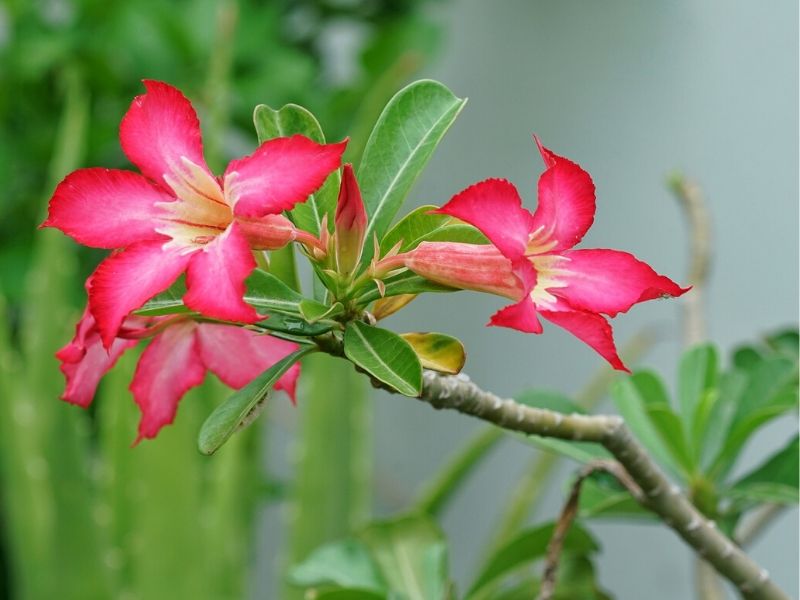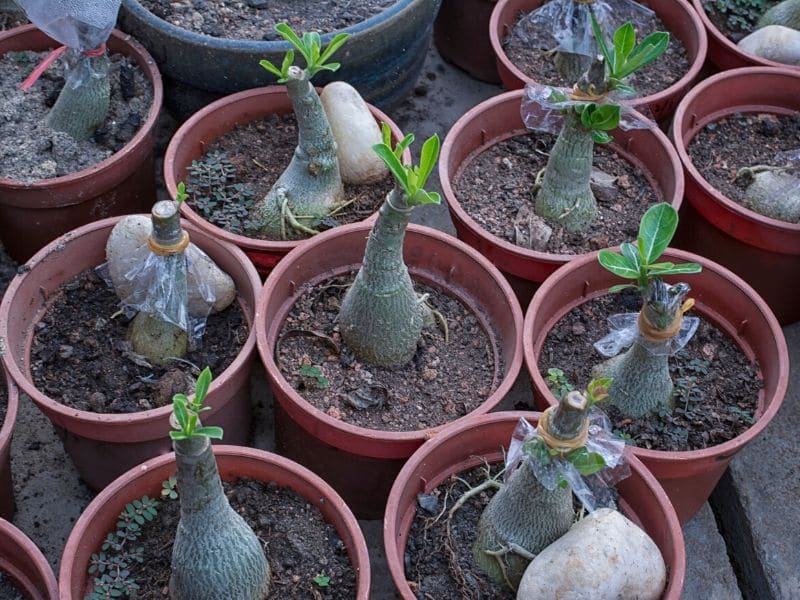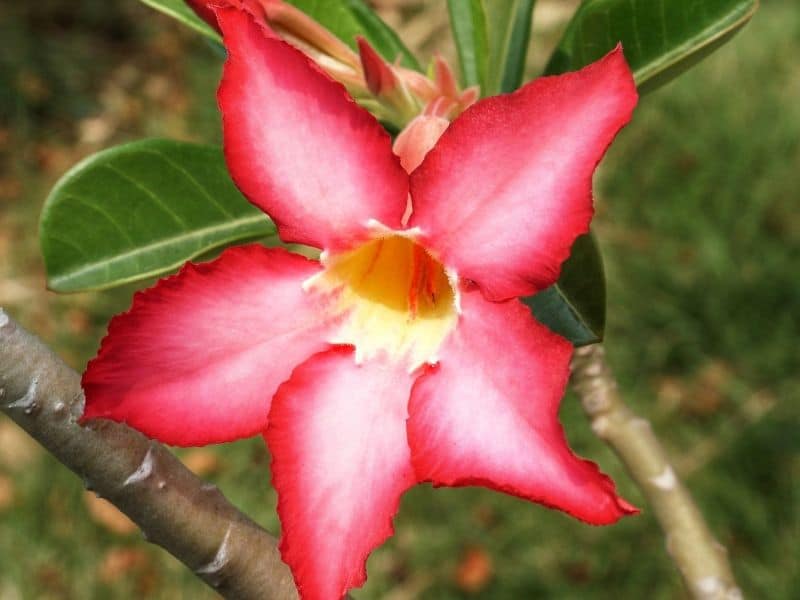Even if you don’t live in a tropical climate, it’s possible to bring all the beauty of the tropics into your home at any time of the year.
Desert rose bonsai, or Adenium obesum, is a small succulent tree native to Africa and Arabia. Left to its own devices, it can grow up to five feet tall but grown in a small container, it’s the perfect bonsai specimen.
This plant is remarkably easy to grow and requires minimal care. Here’s what you need to know.
Interesting Facts About Desert Rose Tree

Height: 5-7 feet
Width: 10”
Sunlight: Full sun
Flowering Time Length: Year-round when grown in full sun
Lifespan: 30+ years (grows slowly)
Scientific name: Adenium obesum
Common names: Sabi star, impala lily, kudu, and mock azalea
How Many Types of Adenium Obesum Are There?
There is really only one desert rose bonsai tree species, but people often think there’s more than one. Why the confusion? Desert rose bonsai can be grown as a large ornamental plant or trained to be a bonsai specimen.
A member of the Adenium genus, desert rose bonsai is one of a dozen or so plants that are typically grown as houseplants in temperate regions. There are several hybrids of this genus that have been developed, each of which is known for its colorful flowers and long lifespan when grown in a pot.
The desert rose bonsai trees you know and love are a favorite among bonsai growers. It grows quickly and grows about eight inches tall when cultivated in this fashion. It has a bulbous base, fleshy leaves, and large, trumpet-shaped flowers of pink and white.
Growing Desert Rose Bonsai
You can propagate this plant using seeds or cuttings. The propagation process is relatively easy to do.

Planting from Seed
It can be a bit challenging to grow desert rose bonsai from seed, but if you start with fresh seeds, you’ll have better luck. Fresh seeds have higher germination rates, so make sure you purchase seeds from a reputable dealer.
Start your seeds in a container with a well-draining medium, like sand and soil or perlite. Cover the seeds lightly with the medium. Water from below and above once every three days until you notice seedlings appear. Then, keep the seedlings on a heating pad so that the temperature of the developing seeds remains higher than 80 degrees.
Usually, seeds will germinate in about a week.
Planting From Cuttings
You can also start desert rose bonsai from cuttings. Do this by taking a cutting from the tip of a branch. Let the cutting dry out for a few days, then wet it and dip it in rooting hormone.
Insert the cutting into your growing medium and water it daily. It should take root in as little as two weeks.
Desert Rose Bonsai Care Guide

Captivated by the Desert Rose’s vibrant blooms and sculptural caudex? Dive into the secrets of bonsai tree care for this mesmerizing succulent, unlocking a world of miniature beauty in your own home.
Sunlight
Desert rose bonsai should never be exposed to temperatures lower than 40 degrees. In the spring, summer, and fall, when temperatures are warm, it can be grown outdoors; you need to bring it inside when temperatures start to dip. Place it on a windowsill with good southern exposure.
Direct sunlight can scorch their leaves, so it’s best to place them near a sunny window with sheer curtains or in an area where they receive filtered light.
If you can’t get your Adenium Obesum Desert in such a position, you may need to use grow lights to give your bonsai enough light.
Watering
As with other bonsai trees, your desert rose bonsai should be watered once a week to every ten days. And it is crucial to allow the soil dry out between waterings. To avoid root rot, make sure the pot has enough of drainage holes on the bottom.
During the winter, you may find that your plant also benefits from being placed in a shallow tray of gravel and water. This will give the plant some extra humidity without oversaturating it.
Fertilizing
Fertilizing is necessary if you want your bonsai to remain lush and green. Keep your tree healthy by using a fertilizer formulated specifically for bonsai plants, or you can use a general-purpose liquid fertilizer.
However, since your plant will be so small, it’s important that you only use it at half strength. It can be applied once a month or once every other month during the winter.
Potting and Repotting
You should repot your desert rose bonsai once every two or three years. Do this in the spring with root-pruning. You will need to use a well draining soil mix to prevent overly soggy soil. Repot into a pot that is at least ⅔ as wide as the current height of your tree.
Pruning a Desert Rose Bonsai
You can prune your desert rose bonsai at any time of the year. If you want more flowers to grow on your desert rose Bonsai tree, trim it in the spring. These tend to appear on new shoots and pruning can encourage more flower buds to develop.
When you prune, make sure you wear gloves. The plant produces a toxic milk sap that can irritate your skin.
Be careful wiring branches, too. This can help you train your bonsai plant, but you need to be careful about wiring too tightly. The branches need to be able to grow thick without wire marks constraining them and leaving unsightly marks.
Pests and Diseases
This plant isn’t prone to many pests and diseases, but you may find that your bonsai falls victim to the same aggressors that usually target other houseplants. Some common culprits include spider mites, mealybugs, and aphids.
The best defense against these pests is to make sure your plant is growing strong and healthy, with all the water, ventilation, and fertilizer it needs. A strong plant will be more resilient against insect attacks.
Where to Buy Desert Rose Bonsai
You can purchase desert rose bonsai, both from seed and as a cutting or bare-root, from most garden supply stores. It’s available on Amazon as well as from online bonsai retailers as well.
FAQs
Can Adenium take full sun?
Yes, Adenium, commonly known as Desert Rose, generally thrives in full sun. It prefers bright sunlight and warmth, making it well-suited for outdoor locations with plenty of direct sunlight, especially in tropical or subtropical climates.
Why do desert rose leaves turn yellow and fall off?
Yellowing and leaf drop in Desert Roses (Adenium) can result from various factors, including overwatering, underwatering, nutrient deficiencies, or pests. Ensure proper watering practices, provide well-draining soil, and monitor for pests to maintain the health of the plant and prevent yellowing leaves.
*Photos by sweemingyoung and [email protected] / depositphotos







